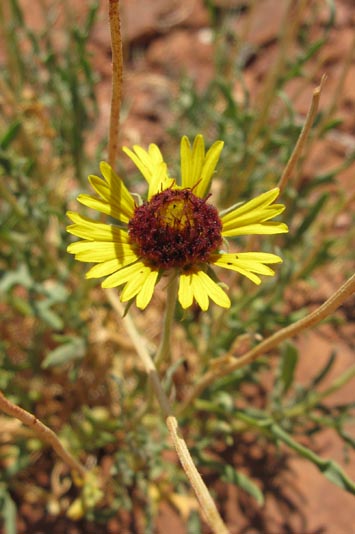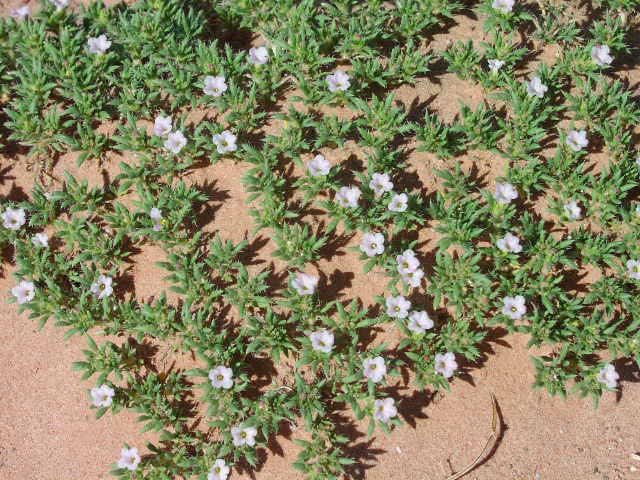Chihuahuan Desert gypsum endemics and the Colorado Plateau flora
Michael Moore, Associate Professor, Oberlin College
My research lab is currently working on a large research project to understand the biogeography and evolutionary history of gypsum endemic plants across the Desert Southwest. These plants grow only on gypsum deposits or gypseous soils, which are scattered in an island-like fashion from north-central Mexico to Nevada and Utah, with the highest concentration of deposits in the Chihuahuan Desert region. Despite the relative isolation of these deposits, many species of gypsum endemic plants are distributed across a wide geographic area. For example, the gypsum endemic grass Sporobolus nealleyi is found on gypsum in southwestern Colorado, east-central Arizona, throughout New Mexico and west Texas, and in northern Mexico. Presumably, it must have taken a relatively long period of time for such plant species to randomly disperse to all of the different gypsum deposits that they currently occupy. Many of these widespread gypsum endemics are also morphologically quite distinct from their nearest non-endemic relatives, which also indicates some antiquity for these gypsum plants.
 |
Gaillardia pinnatifida, southeastern Utah |
My lab is interested in testing whether these gypsum endemics are as old as they seem. We are currently collecting numerous populations of 15 different gypsum endemic groups, including species of Nerisyrenia (Brassicaceae), Acleisanthes and Anulocaulis (Nyctaginaceae), Gaillardia, Oenothera sect. Calylophus (Onagraceae), Mentzelia (Loasaceae), and Sporobolus (Poaceae). Almost all of these genera contain more than one gypsum endemic species. Our goal is to collect multiple individuals from numerous populations throughout the geographic ranges of each gypsum endemic species. We are then generating and analyzing DNA sequence data for these collections in order to understand the phylogeography, or evolutionary biogeography, of these groups. For several of these groups (such as Gaillardia and Nerisyrenia) we are also reconstructing the evolutionary history of the entire genus in order to gain a deeper understanding of gypsum evolution across each genus. By comparing our results across all 15 groups, we hope to discern common patterns of evolutionary history across all gypsum endemic lineages, which may provide more general insight into the assembly of the desert flora of the Southwest. For example, if we discover that these gypsum endemic species are relatively old, and have occupied their current ranges throughout the most recent ice ages in the Pleistocene, then it would suggest that at least some desert plants may have persisted further north than previously thought possible. For more about the Chihuahuan Desert and its gypsum flora, click here.
 |
|
Gaillardia spathulata, southeastern Utah |
A number of these gypsum endemic groups have important species that are present within the Colorado Plateau, making the Colorado Plateau flora of great interest to our research as well. In particular, we are interested in obtaining leaf material of as many populations as possible of the following genera that occur on the Colorado Plateau (whether the individual species are endemic to gypsum or not): Gaillardia (represented in the Colorado Plateau by G. parryi, G. spathulata, G. flava, and G. pinnatifida), Flaveria, Oenothera sect. Calylophus (formerly the genus Calylophus), and Sporobolus nealleyi. We are particularly interested in Gaillardia, as it is possible that the widespread and highly variable species G. pinnatifida may actually consist of multiple species, particularly on the Colorado Plateau. We are also interested in the species Tiquilia latior (Boraginaceae), which is essentially endemic to the Colorado Plateau and frequently grows on gypsum.
We have already made one collecting trip to the Colorado Plateau, and anticipate more, but any and all help is appreciated with obtaining additional leaf material for the above groups. If you are able to provide locality information or even leaf material for any of these groups, please contact Dr. Michael Moore at michael.moore@oberlin.edu or (440) 775-6876.
 |
Tiquilia latior, southeastern Utah |
Last updated on December 31, 2012
All images are the copyright of Michael J. Moore